CO2 Regulator Fittings – Crucial Guide & Recommendations
Were you aware that main regulators in CO2 systems lower tank pressure from 800-900 psi to a more practical 10-30 psi? This not only demonstrates the efficiency of CO2 regulator fittings but emphasizes their indispensable role in securing a ideal pour. They are crucial in applications like kegerators, aquariums, and industrial applications. Understanding CO2 fittings is key for top operation and consistency.
CO2 regulator fittings greatly influence the quality and taste of carbonated beverages. Opting for high-quality CO2 regulator fittings can preserve steady gas pressure, warding off over or under-carbonated beer issues. It is crucial to choose top-notch CO2 fittings from reputable sources like Installation Parts Supply. This guarantees longevity and performance. We explore different fitting variants, setup tips, care recommendations, and decision-making tactics for particular requirements.
Essential Conclusions
- Main regulators play a critical role in lowering high CO2 tank pressure for optimal serving.
- Different beer styles demand unique carbonation settings to achieve the best flavor.
- Steady gas pressure is vital to prevent over or under-carbonated beverages.
- Additional regulators are vital when handling multiple kegs at varying pressures.
- Choosing high-quality fittings from reputable brands can improve system reliability.
Introduction to CO2 Regulator Fittings
CO2 regulator fittings are crucial in controlling carbon dioxide flow and pressure across various fields. These include beverage dispensing, aquaculture, and clinical applications. They regulate the CO2 pressure from a high range (800 to 1000 PSI) to a more regulated range (1 to 40 PSI). This adjustment is critical for the reliable operation of CO2-dependent devices.
The primary parts of CO2 regulator fittings comprise the regulator along with the shut-off valve. The regulator sustains suitable pressure levels, while the shut-off valve supplies manual gas flow control. A important safety feature is the check valve. It’s designed to prevent back-siphoning, upholding the system’s integrity. In aquatic setups, achieving stable pH levels through precise CO2 delivery is essential. Tools such as bubble monitors and pH regulators are indispensable in this process, aiding in plant health.
Choosing reliable CO2 regulator fittings is vital for efficiency in different environments. When choosing fittings, it’s important to evaluate the compatibility of materials with CO2. For illustration, silicone tubing may permit gas to leak out, which can lead to losses. Selecting premium needle valves can prevent problems like ‘end of tank dumps.’ This guarantees safety and preserves consistent CO2 delivery.
The Function of CO2 Regulator Fittings Function
CO2 regulator fittings play a pivotal role in the performance and security of CO2 systems. They ensure consistent pressure, vital to proper carbonation in refreshments. High-pressure CO2 tanks, containing 800 to 900 psi, require pressure reduction to a practical 10-30 psi. Such pressure lowering is essential for serving at the ideal carbonation levels. Primary regulators, vital elements of CO2 regulator fittings, facilitate this process. They often come with a gauge or dual gauges to monitor the gas pressure.
In terms of serving beer, the performance of these fittings is of utmost importance. Uneven pressure can ruin the integrity of the pour. Consequently, the outcome may be beer that’s either over-carbonated or under-carbonated. Because various beer types demand specific carbonation levels, like stouts demanding less carbonation than lagers, additional regulators play a vital role. They allow for adjustments based on the individual requirements of each keg.

For portable dispensing, such as with smaller 74 gram CO2 tanks, mobile beer regulators are perfect. They allow serving from a small setup, perfectly dispensing a 1/4 barrel. Opting for dependable CO2 system regulator fittings is critical. Manufacturers such as Taprite are famous for consistent regulators, improving the brewing operation.
| Type | Pressure Range (PSI) | Application |
|---|---|---|
| Primary Regulator | 10-30 | Applied in typical beer service |
| Dual Gauge Regulator | 0-60 | Monitors both tank and serving pressures |
| Secondary Regulator | Varies | Used for pressure adjustment across several kegs |
| Mobile Beer Regulator | 10-14 | Ideal for on-the-go serving from small tanks |
Knowing the roles and specifications of CO2 regulator fittings can enhance a serving setup. Regularly checking pressure gauges and fittings secures that the system functions perfectly. This diligence leads to superior service quality.
Categories of CO2 Regulator Fittings
While picking CO2 regulator fittings, it’s important to understand the varieties available for optimal operation in different scenarios. The key categories are single gauge and dual gauge regulator fittings. Each has unique functions, suiting the requirements of a range of applications from entry-level home brewing to intricate industrial operations.
Single Gauge Regulator Fittings
Engineered for entry-level use, single gauge regulator fittings are ideal for manual adjustment needs. They come with a sole gauge indicating the gas’s output pressure. Well-suited to minor projects like home kegerators or microbreweries, they offer ease of use over complexity. Examples include Brewmaster and Fermentap are known for offering simple and effective solutions.
Dual Gauge Regulator Fittings
Dual gauge regulator fittings are engineered to deliver more comprehensive monitoring by displaying both the output and the remaining tank pressure. They are essential to advanced operations, including industrial brewing. This twofold monitoring helps users avoid potential disasters like keg explosions or gas leaks. If you require higher accountability, manufacturers such as KOMOS and Taprite offer a wide selection of dual gauge options.
| Category | Benefits | Best For | Brand Examples |
|---|---|---|---|
| Single Gauge Regulator Fittings | User-friendly, straightforward adjustments | Home brewing, small kegerators | Brewmaster, Fermentap |
| Dual Gauge Regulator Fittings | Accurate dual readings | Commercial brewing, complex systems | KOMOS, Taprite |
Deciding on the Right CO2 Regulator Fittings for Your Requirements
Choosing the appropriate CO2 regulator fittings requires careful evaluation. These aspects improve the CO2 system’s functionality and security. First, assess the pressure range that matches your application, confirming the fittings withstand the specific PSI levels. You must verify compatibility with CO2 sources like CGA-320 valves for a seamless connection. Also, emphasize durability to avoid leaks and malfunctions in your CO2 system.
Important Aspects in Choosing Fittings
- Operating Pressure: The fittings must handle your system’s PSI needs.
- Material Quality: Select high-quality materials, such as stainless steel, for robustness.
- Compatibility: Verify the fittings are compatible with your CO2 sources.
- Ease of Installation: Look for designs that simplify installation.
Recommended Brands for High-Quality CO2 Fittings
Prioritizing well-established brands is key for the best system performance. Installation Parts Supply is recognized for offering premium CO2 regulator fittings. Their selections combine quality and cost, appealing to both hobbyists and professionals. The Milwaukee MA955 solenoid, priced around $40 CAD, is praised for its performance and dependability. Additionally, the Aqualabs regulator and the Dici regulator with a bubble counter are economical, priced at $50 to $60 CAD on Amazon. These brands are top picks for enhancing your aquarium system.
Installation Advice for CO2 Regulator Fittings
Mounting CO2 regulator fittings requires a keen attention to intricate details and adherence to critical safety guidelines. Correct assembly secures that the system operates effectively. It also protects against leaks that could be hazardous. To achieve proper installation of CO2 regulator fittings, follow these recommendations:
- First, checking the shut-off valve. Confirm it is in the off position before continuing with installation, as this stops unexpected gas discharge during the setup procedure.
- Apply appropriate sealing techniques to all threaded joints. Teflon tape can be a useful tool to create a leak-proof seal without any danger of seepage.
- Configure the CO2 regulator to the proper pressure, which is key to reaching ideal carbonation and preventing excessive pressure that could damage your system.
- Following installation, vent the gas step-by-step to allow for accurate pressure readings and eliminate any residual air.
- Once installed, perform a comprehensive leak check. Utilizing a soapy water solution can help identify potential leak points, guaranteeing safe operation.
By adhering to these installation tips, you can greatly enhance both the efficiency and integrity of your dispensing system.
Upkeep and Issue Resolution for CO2 Regulator Parts
For best results with your CO2 regulator fittings, routine care and early troubleshooting are key. Consistent monitoring reveals issues promptly. Inspecting for leaks is a must. A soap test can easily spot leaks, where bubbles indicate a need for repair.
Correctly securing internal parts is essential, with a 7/8 socket wrench advised for just beyond finger tight. Keeping the regulator’s integrity ensures its long life. Reassembling with 75 foot/lbs of torque is advised. After repair, the regulator should read above 40 PSI. Sometimes, an additional 1/4 turn is required for proper pressure.
Installation errors or missing washers can result in leakage, leading to swift CO2 depletion. Beer regulator pressure relief valves are designed to trigger under 60 PSI. However, there can be instances of release at higher pressures. Diaphragm or cartridge failure often necessitates regulator rebuilds.
Brands differ in their operational characteristics. Despite its popularity, the Milwaukee MA957 faces needle valve criticisms and is backed by a 6-month warranty. CMBecker’s 5-year warranty speaks to their trust in their product’s durability.
Proper maintenance extends CO2 systems’ lifespan. Familiarity with your regulator’s parameters, for instance Taprite’s 0-50 PSI, helps with repairs. Taprite’s products accommodate multiple beverage pressure requirements, proving versatile.
Budget CO2 Fittings vs. High-End CO2 Regulator Fittings
The decision between budget-friendly CO2 fittings and high-end CO2 regulator fittings rests on their price. Basic options can begin around $20, whereas premium products often start at $200. To illustrate, a budget CO2 setup with a basic regulator attached to a standard 5 lb cylinder could be priced between $150 to $175. Alternatively, a premium CO2 system could cost up to $625, based on brand and performance.
High-quality components are key to reliable CO2 systems. Users note that high-grade regulators enable precise pressure control, vital for sub-10 gallon tanks. Additionally, a majority of users prefer paying more for complete systems, for the sake of convenience and proven quality. Assembly by companies versus individual manufacturing can lead to significant price differences.
There’s potential for savings when individuals opt to buy parts separately and assemble themselves by around 20-30% relative to complete kits. There is significant price variation in components like solenoids and metering valves. Solenoids can cost between $20 and $50, while metering valves may cost from $17 up to over $200, depending on their quality and function.
A 5 lb aluminum CO2 tank, costing approximately $60, adds to the overall cost. Users have mixed opinions on products like the KOMOS® Premium Dual Gauge CO2 Regulator, which is priced at $59.99. It has an operating pressure range up to 60 PSI and an unspecified maximum flow rate. This regulator also comes with a pressure relief valve that triggers at 65 PSI.
In terms of durability and efficiency, nearly 70% of users are pleased and about 80% would endorse it for homebrewing. Despite this, there are concerns such as slow leaks, experienced by 10% of users. The willingness to invest more stems from a desire for dependable performance, an essential factor in choosing between budget-friendly and premium CO2 fittings and regulators.
As a Final Point
Choosing the right CO2 regulator fittings is vital for your system’s operation, integrity, and budget performance. We have outlined critical points, including varieties of CO2 regulator fittings and factors to guide your decision. An appropriate regulator is essential for consistent carbonation in draft beer and long-term system dependability.
While premium fittings may cost more initially, they offer enhanced durability and simpler maintenance. Reputable brands such as Airgas, Taprite, and Micromatic deliver exceptional reliability. They satisfy the diverse needs of users, guaranteeing lasting satisfaction and performance.
Consulting reputable suppliers, such as Installation Parts Supply, is advisable for anyone planning to set up or upgrade a CO2 system. Access to top-notch products and expert advice can greatly improve your system’s functionality. Quality fittings are an investment in the efficiency of both homebrewing setups and commercial operations.
Frequently Asked Questions
What do CO2 regulator fittings do and why are they important?
CO2 regulator fittings manage the flow and pressure of CO2 in systems such as kegerators, aquariums, and diverse systems. They serve an important function in maintaining the system’s efficiency and security by maintaining CO2 levels.
What varieties of CO2 regulator fittings are available?
The main types are single gauge and dual gauge regulator fittings. For simple setups like home kegerators, single gauge fittings offer basic, manual control. Dual gauge fittings provide detailed pressure data and are well-suited for commercial and advanced applications.
How do I select the best CO2 regulator fittings for my application?
Choosing the right CO2 regulator fittings involves considering the pressure needs, fit with your CO2 supply, and build standards. Ensure high durability and safety to avoid leaks and ensure efficient system functioning.
What are some recommended brands for high-quality CO2 fittings?
Brands like Installation Parts Supply are reputable suppliers of dependable CO2 regulator fittings. Choosing reputable brands enhances your system’s safety and performance.
What installation tips should I follow for CO2 regulator fittings?
Make sure every connection is secure and leak-free during installation. Adjust the pressure appropriately and vent gas in order to achieve accurate readings. Consult detailed installation guides for further assistance.
What maintenance practices are important for CO2 regulator fittings?
Consistent upkeep is essential to keeping your system running smoothly. Monitor for leaks, adjust pressure as needed, and resolve common problems promptly. Following these guidelines maintains system performance.
Is it worthwhile to invest in high-end CO2 regulator fittings?
Absolutely, top-tier fittings from established manufacturers can lead to savings by minimizing repair and replacement needs. They provide enhanced performance and improved operational consistency.

